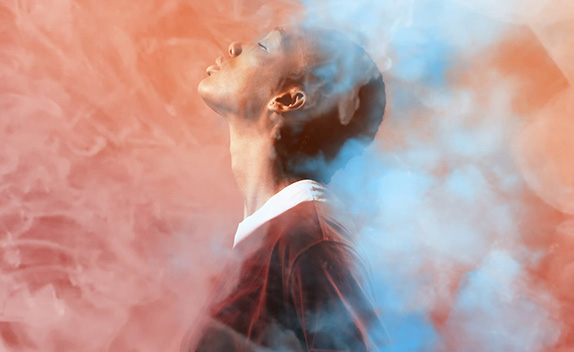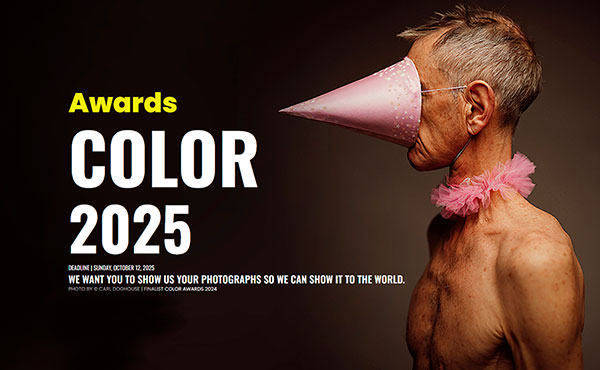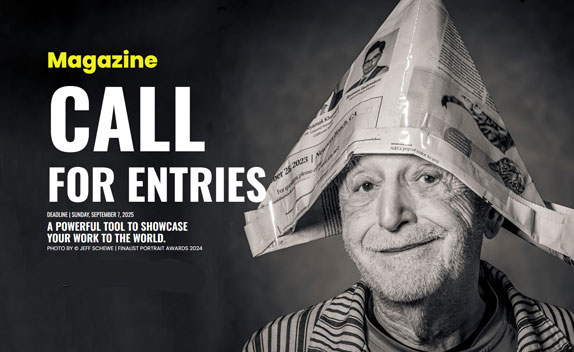Cibografia is my way of seeing. A visual language that uses food to speak of matter, shadow, and light. A continuous search for meaning in what is usually consumed too quickly.
HomeCategory
Concept
Elusive is a photographic project by Emilie Möri that invites viewers to immerse themselves in a world of illusion and escape, where imagination is the only limit. Through digital collages, minimalist compositions, and natural light, Möri creates images that evoke silence, mystery, and a delicate balance between reality and dream
For me, Polaroids are not just photographic objects: they are “effects” of personal memory. They have reopened a window to childhood, not so much out of nostalgia, but because of that sense of urgency and immediacy that only certain images possess.
The United Nations has declared the border between the United States and Mexico to be the deadliest land crossing in the world and a humanitarian crisis. Thousands of men, women, and children have died crossing.
In a world obsessed with movement, progress, and hyper-connectivity, (An)Organic presents a visual meditation on stillnesswhether embraced or inevitable. This ongoing fine art photography series explores the alienation of ordinary individuals through artificial figuressynth etic forms of silicone, porcelain, and other materials while subtle surreal elements shape a hypnotic yet unsettling atmosphere.
As time moves relentlessly forward, it leaves traces of the past subtle and profound etched into landscapes, objects, and human relationships. The images in this project form components of an ethereal tapestry that weaves together echoes of the past, outlines of memories, and whispers of dreams.
I have always loved dance and movement. As a child, I was constantly in motion, dancing to the Beatles or pretending to be a ballerina. Even when seemingly at rest, I "moved." I would lie on the living room couch, staring up at the cathedral ceiling, dreaming of the world upside down.
ELEPHANT is a deeply personal photographic exploration of empty nest syndrome, sparked by my son's departure for his studies. His absence created a suffocating emptiness in our home an unspoken weight that materialized as an elephant in the room.
As an illustrator and sculptor of scenic objects for her photographic compositions, she draws inspiration from nature, forests, the sea, and mystery, immersing herself in a continuous interplay between reality and imagination. As an illustrator and sculptor of scenic objects for her photographic compositions.
With an old Polaroid camera, I preserve memories and fleeting contemplations. I capture ordinary things and situations: the transient moments of daily life. My aim is to convey a sense of melancholy and loneliness.
This body of work is a series of staged photographs featuring still life compositions with a female figure.
In the history of art, still life paintings have traditionally been characterized by the total absence of the human figure.
This series visually communicates my personal journey through the clinical, sterile IVF treatments and the physical and mental pain of this process.
This photo series is called "Louzolo," which means "Love" in Kikongo, a local Congolese language. The series explores love languages in Congolese society—the dos and don’ts, what is acceptable and what is not. How much is too much? How can one express love in public?
Altered states of consciousness have been a fascination of mine since my introduction to meditation techniques in the late '90s. Through practice and study, the culmination of this journey can best be described by the integral theory of philosopher Ken Wilber.
Most people are more likely to use photographs to distract themselves from the deterioration and loss of people, objects, and situations that they hold dear. Reassembling images that remind me of my beneficial experiences challenges me and other viewers to recognize differences between photographs and memories.
I love dunes - these perfect harmonious shapes and lines. Such perfect proportions, not touched by a human hand, are difficult to find anywhere else. Once abstracted from their surroundings, sand dunes reveal their beauty and clean forms, which can be presented freely from different angles, distances, and perspectives, and with boosted colors.
The terrified nameless citizenry of 1950s and 60s B-movies, dressed in colorful outfits, are caught in horrified poses as they scream, flee, and try to shoot their way out of certain death from off-screen monsters looking to squash them: natural disasters, giant crickets, and alien landings.
Cycling and walking along the western coast of Liguria (the Mediterranean coast in the northwest of Italy) between October and May, the places you come across, usually crowded in high season, are a mix of a recent end and a new beginning.
As we all know, a photograph has the power to tell both the truth and a lie at the very same moment. Yet its real magic lies in its ability to transcend reality. As the years pass, I realize that I am drawn to using photography as a tool to create new worlds and realities that come to life through my imagination and vision.
Behind every shot lies a journey through lines, shapes, and spaces in constant evolution. I primarily photograph modern architecture and its details, focusing on black-and-white fine art. My work deliberately excludes any human presence, allowing the lines and forms of the architecture to take center stage.
Each image I create is a window into the uniqueness of the body as a vehicle for experiencing life, narrating fragments of a story that has no end. Beyond the visual, I want those who contemplate my work to allow themselves to feel, to reconnect with their emotions, and to reflect on the essence of who we are.
For me, traveling by train has always been comparable to life: being on the move from one place to another, with changing fellow passengers and so many interesting things to see and experience around me.
In my dream I walk through the rooms that feel familiar and strange at the same time and enter through a door into another room full of shuttered windows. I open the shutters and see that the house is surrounded by the stillness of the sea.
Forest is an exploration of the boundaries between the perception of nature and the human inner world, an attempt to convey the complexity of emotions and sensations that arise in moments of solitude. These works were created at night, when light and darkness form a tenuous border between reality and nightmare.
Much more than an aesthetic object, the mirror has fascinated and influenced the culture and art of many peoples. Historically it is the first virtuality device, or augmented reality, not only a "duplicator" of reality, but also a transformer of it.
Paola began photographing as a child, when her father gave her his Zeiss so that she could learn to love the hobby that he so enjoyed and at the same time scolded her because she tended to frame by deviating from the canons of photography at the time.
I became fascinated with Hieronymus Bosch’s “Garden of Earthly Delights” as a teenager. His limitless imagination and intricately detailed images captured my mind. I put these details center stage, using models, wardrobe, special prosthetics and specially-built props to create photographic facsimiles of Bosch’s original paintings.
After the Fire: Water Damaged, explores photographs as memory by examining the shape-shifting potential of altered images. As a result of a fire above my studio, water impacted my negatives destroying a third of my archive.
I simply don’t remember about the past or never really thought about remembering the past. I have never been one to hold on to the past, but after my mother's death, I found myself troubled by memories of her. What I remember about my mother is mostly from the time I cared for her.
In the study of history of photography it’s easy to see how light is fundamental, in fact photographers of every ages have been able to create atmospheres, communicate sensations and show the movement of surfaces through more or less intense contrasts of lights and shadows.
In a moment of high voltage between Photography and AIgraphy in which the old spits plague and horns on the new (as has happened since the origin of humanity), it is precisely Juan Pablo's “bicephalism” between Photography and AIgraphy that has me taken to interview him, hoping that this can make us reflect, making room for this new way of creating visual art that will surely assume a predominant position in our lives.
The formation of a caldera creates an environment where familiar foundations crumble, leaving everyone inside trapped within a new and uncertain territory. Similar to intense heat and pressure within a caldera, the experience of forced immigration can evoke feelings of disorientation, fear, and despair.
The world is becoming increasingly unimaginable, a world of global disasters, cybercapitalism running amok and the potential threat of extinction, drags us into a kaleidoscopic vortex of confusion.
The length of the exposure causes the film to solarize, turning the sun's path into a dark, vaguely extraterrestrial streak cleaving across the sky in each frame. The exact time of each exposure is dictated by the duration of specific phone calls, allowing inferences to be made about the nature of the relationship and conversation that each photograph records.
A few tenths of a second one spends rolling is a moment beyond our control. This is the moment when each individuality emerges, whether it’s a character, a gift, or a result of hard work (although one might not consider denguri-gaeri as hard work).
The Red Purse tells a story of transition, of rebuilding. The project grew from a journey, my journey, of navigating through—and beyond-- the darkness and uncertainty of young widowhood.
In 2007, I embarked on a journey to liberate my voice through singing lessons, seeking to free not just the sound but also my expression. This path quickly took an unexpected turn when, after a particularly discouraging class, I turned to my camera as a tool for introspection.
This project started just before loss took place. Just before the final derailment and the total breakdown. It was the preparation of the inevitable. Like a cloud getting ready to rain. And when it started to rain it was then, that I let the pictures pour out of me.
In fairy tales, shoes are imbued with enchanted powers: they save, they transport, and they contain their heroes and heroines. They have long been symbolic, representing aspirations, transformation, and the search for one's place in the world.
José Ramón Fernández's photo collection serves as a representative selection of a recurrent theme in his photographic work. In these images, the human figure is depicted within a wide general plane, appearing as if merely accidental or transitory within the solid, permanent spatial framework.
Orphic evanescences is a project that i conceived with the aim of exploring the fleeting nature of existence through the medium of photography, emphasizing the connection between the proustian concept of time and the principle of the feminine as a creative force.
This project encapsulates the essence of a transformative journey through the medium of personal storytelling. It is an intimate reflection of the individual's life, marked by significant memories and events that have shaped their identity. By transcribing these pivotal moments and revisiting them, the person engages in a profound dialogue with their past, applying a method of listening akin to their approach to music.
I haven’t been home for more than three years. I'm not even sure if my home is Moscow anymore. Every morning since leaving Russia, I have taken a self-portrait. The rules are simple: take a photograph right after waking up. No matter where, how, or with whom. This is my documentation of impermanence, the ritual that helps me stay grounded.
Giovanni Sellari's project, "The Stressonauts," was born from his personal need for a momentary escape from daily life, from the intimate and inescapable desire to find the space and time to devote to one of the most indispensable activities for maintaining a psychophysical balance: idleness.
In Ancient Greek, the word kosmogonía means creation of the world, from kósmos (order, world, universe) + gónos (creation, begetting). The Kosmogonía series interweaves the human, the animal, and the vegetal.
Many people experience loneliness, but they may not fully understand the feelings and discomfort caused by this emotion. Lonely people often feel a lack of understanding and connection, regardless of the number of social contacts.
In this virtual table I wanted to represent a personal diary with a series of photographs taken of different subjects, in different places and in different situations. Designing this moodboard was a fun and creative way to travel back in memory, in a sort of mental map, which allowed me to calmly organize a lot of material, in order to find an original interpretation that told of me.
In the photographs there are thematic elements interrelated, mutually influencing each other that become distinct over the course of the photographic years. The dominant element of my photography is the person who is ultimately also the ....starting point of the subjects I photograph.





